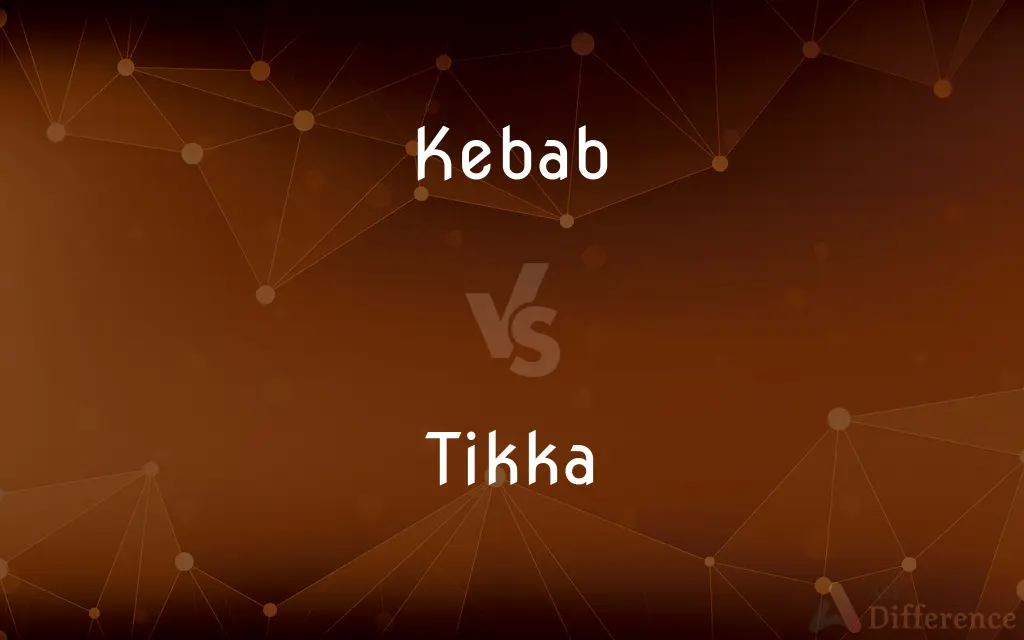Kebab vs. Tikka — What's the Difference?
By Tayyaba Rehman — Updated on September 28, 2023
Kebab usually refers to grilled meat, often on skewers, originating from Middle Eastern cuisine, while Tikka is typically chunks of marinated, skewered, and grilled meat, originating from Indian cuisine.

Difference Between Kebab and Tikka
Table of Contents
ADVERTISEMENT
Key Differences
Kebab and Tikka are delightful dishes predominantly made with grilled meat, originating from different culinary traditions. A kebab is a broad term primarily used in Middle Eastern cuisine to describe a variety of grilled meat dishes, often consisting of ground or minced meat, typically beef or lamb, seasoned with spices, and sometimes paired with vegetables, threaded onto skewers. In contrast, Tikka refers to a dish in Indian cuisine, traditionally made with small, boneless chunks of meat, usually chicken, that are marinated in a mixture of yogurt and spices before being skewered and grilled.
While the kebab has a wide range of variations, including some without skewers like the doner kebab, Tikka usually maintains a consistent preparation method involving marinated, skewered, and grilled pieces of meat. A kebab can be made with different types of meat and can be served in various ways, including on flatbread or as part of a platter with accompaniments like rice and vegetables. Tikka, notably Chicken Tikka, is often served with Indian bread like naan or rice and accompanied by chutneys or sauces, maintaining a distinct flavor profile characterized by the rich marinade of yogurt and spices.
In terms of spices and flavors, kebabs, owing to their Middle Eastern origins, tend to have a robust and aromatic spice profile, utilizing ingredients like cumin, coriander, and paprika, giving them a savory and sometimes spicy flavor. Tikka dishes, reflective of Indian cuisine, are known for their vibrant and diverse spice palette, utilizing spices like garam masala, turmeric, and chili powder, imbuing the dish with a complex, flavorful, and often spicier taste.
Another significant distinction is the accompaniments and the way these dishes are served. Kebabs are often accompanied by a variety of side dishes like salads, grilled vegetables, or rice and are sometimes wrapped in flatbreads, making them versatile and suitable for different dining settings. Tikka, on the other hand, is typically served with Indian bread or rice and is accompanied by a variety of chutneys, sauces, or dips, complementing the rich and flavorful nature of the dish.
In conclusion, while kebabs and tikka are both mouth-watering grilled meat dishes, they differ in their origins, preparation methods, spice profiles, and accompaniments, with kebabs stemming from Middle Eastern cuisine and having varied presentations, and tikka originating from Indian cuisine, known for its rich marinade and vibrant flavors.
ADVERTISEMENT
Comparison Chart
Origin
Middle Eastern cuisine.
Indian cuisine.
Preparation Method
Can be ground or minced meat, sometimes on skewers.
Boneless chunks of marinated meat, usually on skewers.
Spice Profile
Aromatic spices like cumin and coriander.
Rich spices like garam masala and turmeric.
Accompaniments
Served with salads, rice, or wrapped in flatbreads.
Served with Indian bread, rice, and chutneys.
Variations
Wide range, including dishes without skewers.
Typically consistent in preparation method.
Compare with Definitions
Kebab
Often paired with vegetables and served with accompaniments like rice or salad.
For dinner, I had a beef kebab served with grilled vegetables and rice.
Tikka
Usually served with Indian bread like naan or with rice.
We enjoyed our tikka with some garlic naan on the side.
Kebab
A term for various skewered, cooked, or grilled meat dishes.
I enjoy a doner kebab wrapped in flatbread with plenty of vegetables.
Tikka
An Indian cuisine dish known for its rich marinade and vibrant flavors.
We ordered paneer tikka as a vegetarian option, and it was delicious.
Kebab
Kebabs are various cooked meat dishes with their origins in Middle Eastern cuisine. Numerous variants are popular around the world.
Tikka
Reflective of the diverse and rich spice palette of Indian cuisine.
The tikka had a harmonious blend of spices, showcasing the complexity of Indian cuisine.
Kebab
A dish of pieces of meat, fish, or vegetables roasted or grilled on a skewer or spit.
Tikka
A dish of small pieces of meat, typically chicken, marinated in spices and yogurt, skewered and grilled.
The chicken tikka was tender, flavorful, and perfectly grilled.
Kebab
Shish kebab.
Tikka
Accompanied by chutneys, sauces, or dips to complement the flavors.
The tikka came with a mint chutney that added a refreshing taste.
Kebab
(British) A dish of pieces of meat, fish, or vegetables roasted on a skewer or spit, especially a doner kebab.
Tikka
A pendant attached by a chain so as to hang from the parting of the hair to the middle of the forehead, worn especially by Hindu brides.
Kebab
(AU) A hand-held dish consisting of pieces of meat roasted on an upright skewer mixed with fresh vegetables and sauces and rolled up in a round piece of unleavened bread.
Tikka
A bindi.
Kebab
(US) A shish kebab or any other food on a skewer.
Tikka
A South Asian dish consisting of pieces of chicken or other meat marinated in yogurt and spices and cooked on a skewer.
Kebab
A restaurant that sells kebabs
Let's go to the kebab after the club.
Tikka
A marinade made from various aromatic spices usually with a yoghurt base; often used in Indian cuisine prior to grilling in a tandoor.
Kebab
(chemistry) The outward growing portions of a shish kebab structure.
Kebab
A Muslim, usually of southern European, Middle Eastern, or North African descent.
Kebab
The vulva.
Kebab
(GUI) menu icon of three vertical dots
Kebab
(transitive) To roast in the style of a kebab
Kebab
To stab or skewer
Kebab
See kabab and kabob.
Kebab
Cubes of meat marinated and cooked on a skewer usually with vegetables
Kebab
A Middle Eastern dish of ground meat, often mixed with spices.
The kebab had a delightful blend of spices and herbs.
Kebab
Can include a variety of meats like beef, lamb, chicken, or fish.
At the barbecue, they were serving an array of kebabs using different meats.
Common Curiosities
What is the origin of Kebab?
Kebab originates from Middle Eastern cuisine.
What is a common meat used in Kebab?
Lamb is a commonly used meat in making kebabs.
What is the origin of Tikka?
Tikka originates from Indian cuisine.
Is Kebab always served on skewers?
No, kebab has various forms, and some are not served on skewers, like the doner kebab.
Is Tikka always spicy?
While Tikka is known for its rich spices, the level of spiciness can vary, and some versions may not be very spicy.
What is a common meat used in Tikka?
Chicken is a commonly used meat in making tikka, as in Chicken Tikka.
Can Kebab be made with vegetables?
Yes, vegetables can be included in kebabs, either mixed with meat or solely as veg kebabs.
Can you have a Kebab as a sandwich?
Yes, certain types of kebabs like the doner kebab are often served as sandwiches wrapped in flatbreads.
Is Tikka served with sauce?
Yes, Tikka is often served with various sauces, dips, or chutneys to complement its flavors.
How is Tikka typically served?
Tikka is typically served skewered and grilled, accompanied by Indian bread or rice and chutneys.
Are there vegetarian options for Tikka?
Yes, vegetarian tikka options are available, typically made with paneer.
How is Tikka flavored?
Tikka is flavored with a marinade of yogurt and a variety of spices, giving it a rich and vibrant taste.
Are there vegetarian options for Kebab?
Yes, there are vegetarian kebab options, often made with paneer or vegetables.
Can fish be used to make Kebab?
Yes, fish can be used to make kebabs, offering a lighter, piquant flavor.
Is Kebab primarily a dish of ground meat?
While many kebabs are made with ground meat, there are also varieties made with chunks of meat.
Share Your Discovery

Previous Comparison
Cowardly vs. Yellow
Next Comparison
Omentum vs. MesenteryAuthor Spotlight
Written by
Tayyaba RehmanTayyaba Rehman is a distinguished writer, currently serving as a primary contributor to askdifference.com. As a researcher in semantics and etymology, Tayyaba's passion for the complexity of languages and their distinctions has found a perfect home on the platform. Tayyaba delves into the intricacies of language, distinguishing between commonly confused words and phrases, thereby providing clarity for readers worldwide.














































